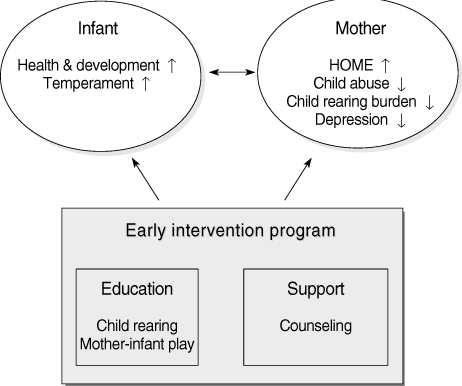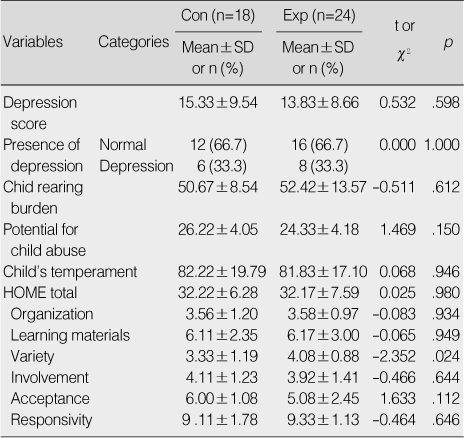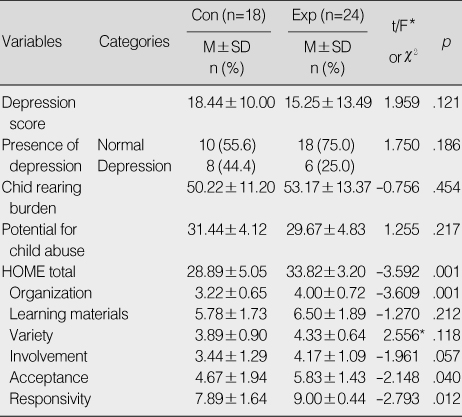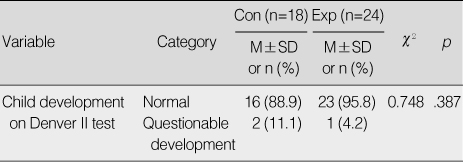Articles
- Page Path
- HOME > J Korean Acad Nurs > Volume 39(6); 2009 > Article
-
Original Article
- Effects of an Early Nursing Intervention Program for Infants' Development and Mother's Child Rearing in Poverty
- Kyung-Sook Bang
-
Journal of Korean Academy of Nursing 2009;39(6):796-804.
DOI: https://doi.org/10.4040/jkan.2009.39.6.796
Published online: December 31, 2009
Associate Professor, College of Nursing, Ajou University, Suwon, Korea.
- Address reprint requests to: Bang, Kyung-Sook. College of Nursing, Ajou University, San 5 Woncheon-dong, Youngtong-gu, Suwon 443-721, Korea. Tel: 82-31-219-7016, Fax: 82-31-219-7020, ksbang@ajou.ac.kr
Copyright © 2009 Korean Society of Nursing Science
Abstract
-
Purpose
- This quasi-experimental study was performed to evaluate the effectiveness of an early nursing intervention program to support mothers of children aged 0-3 yr living in poverty.
-
Methods
- In this study, mothers who received financial support from the government were recruited from one city and assigned to an intervention group (24) and comparison group (18). They completed a baseline questionnaire about depression, child rearing burden, agreement on physical punishment, and child temperament. Also, Denver II screening of the children was performed by the researcher. Mothers in the intervention group received a home visit intervention every two weeks for three months. At 3-months post-baseline, questionnaire and Denver II screening were reused to compare these two groups.
-
Results
- Mother's depression, child rearing burden, agreement on physical punishment, and child temperament were not significantly different between the two groups. However, the percentage of depression declined only in the intervention group. Mothers in the intervention group showed higher Home Observation for Measurement of the Environment (HOME) scores than mothers in the comparison group.
-
Conclusion
- The findings of the study show that this nursing intervention is an effective parenting program. The early nursing program for mothers with infant and toddlers in poverty is effective in promoting HOME, the child rearing home environment.
This work was supported by a Korea Research Foundation grant from the Korean government (KRF-2007-E00153).
- 1. Aboud FE. Evaluation of an early childhood parenting programme in rural Bangladesh. Journal of Health Population and Nutrition. 2007;25:3–13.PubMedPMC
- 2. Ahn HY. Predictive model of child abuse in mothers. 1998;Seoul, Seoul National University. Unpublished doctoral dissertation.
- 3. Anderson LM, Shinn C, Fullilove MT, Scrimshaw SC, Fielding JE, Normand J, et al. The effectiveness of early childhood development programs. American Journal of Preventive Medicine. 2003;24:32–46.ArticlePubMed
- 4. Bang KS. Effects of maternal role education program on the mother-infant interaction and infant development. Unpublished doctoral dissertation. 2000;Seoul, Seoul National University.
- 5. Bang KS. Health status of preschoolers depending on the socioeconomic status. Korean Parent-Child Health Journal. 2006;9:140–149.
- 6. Bang KS, Yang S, Hyun HJ, Kim JS. Health and child rearing status of infants and preschool children in poverty- For the We Start program in Kyunggi province-. Journal of the Korean Society of Maternal and Child Health. 2008;12:104–115.Article
- 7. Barnard KE. Nursing child assessment satellite training, learning resource manual. 1978;Seattle, WA, University of Washington.
- 8. Belsky J, Melhuish E, Barnes J, Leyland AH, Romaniuk H. The national evaluation of sure start research team effects of sure start local programmes on children and families: Early findings from a quasi-experimental, cross sectional study. British Medical Journal. 2006;332:1476. PubMedPMC
- 9. Bradley RH, Corwyn RF. Socioeconomic status and child development. Annual Review of Psychology. 2002;53:371–399.ArticlePubMed
- 10. Caldwell BM, Bradley RH. Home observation for measurement of the environment. 1984;Little Rock, AR, Center for Child Development and Education, University of Arkansas.
- 11. Caughy MO, Huang KY, Miller T, Genevro JL. The effects of the health steps for young children program: Results from observations of parenting and child development. Early Childhood Research Quarterly. 2004;19:611–630.Article
- 12. Cohen J. Statistical power analysis for the behavioral science. 1988;2nd ed.Hillsdale, MI, Lawrence Erlbaum Associates Publishers.
- 13. Dix T, Meunier LN. Depressive symptoms and parenting competence: An analysis of 13 regulatory processes. Developmental Review. 2009;29:45–68.Article
- 14. Fergusson DM, Grant H, Horwood LJ, Ridder EM. Randomized trial of the early start program of home visitation. Pediatrics. 2005;116:803–809.
- 15. Han KJ. The study on the maternal burden of caretaking, the support and educational need for the caretaking activities of the infants' mother. Journal of Korean Academy of Child Health Nursing. 1997;3:228–240.
- 16. Han KJ, Bang KY, Kwon MK, Kim JS. The study on the development and effectiveness of parent role education program. Journal of Korean Academy of Nursing. 2001;31:417–431.ArticlePDF
- 17. Hwang HW. Selected predictors of family poverty and their effects on the socioemotional development of African-American young children. Korean Journal of Family Welfare. 2004;9:219–229.
- 18. Kim HR, Kim MS, Jung SA, Park HR, Kang KH, Noh HR. Report on need assessment for We Start village in Seoul. 2005;Seoul, Social Welfare Research Center, Seoul National University..
- 19. Kim JL, Yoon HM. Mothers' attitude toward corporal punishment and child maltreatment. Journal of Human Ecology Research. 2002;6(2):77–93.
- 20. Kim JM, Kwak KJ. The effect of the parent variables, home environment stimulation and social support on poverty in early childhood. Journal of Korean Child Studies. 2007;28:305–317.
- 21. Kim MG, Kim TW. Poverty in Korea: Current status and policy issues. Social Security Research. 2004;20:173–200.
- 22. Kong GS. Preliminary study on home-visiting program for the prevention of child abuse and neglect. Social Welfare Studies. 2000;15:1–18.
- 23. Ku IH, Park HS, Chung IJ, Kim KH. A panel study on the relationship between poverty and child development. Korean Journal of Social Welfare. 2009;61:57–79.Article
- 24. Lee BJ, Kim MS, Yang S. Manual for We Start program. 2006;Suwon, Gyeonggi Provincial Government.
- 25. Lee HJ, Kim YH, Park NH. A comparative study on family perception between abused children and normal children by kinetic family drawing. Journal of Korean Academy of Nursing. 2006;36:265–277.ArticlePubMedPDF
- 26. Norr KF, Crittenden KS, Lehrer EL, Reyes O, Boyd CB, Nacion KW, et al. Maternal and infant outcomes at one year for a nurse-health advocate home visiting program serving African Americans and Mexican Americans. Public Health Nursing. 2003;20:190–203.ArticlePubMed
- 27. Pridham KF, Chang AS, Chiu Y. Mothers' parenting self-appraisals: The contribution of perceived infant temperament. Research in Nursing & Health. 1994;17:381–392.Article
- 28. Reynolds AJ. Research on early childhood interventions in the confirmatory mode. Children and Youth Services Review. 2004;26:15–38.Article
- 29. Reynolds AJ, Mathieson LC, Topitzes JW. Do early childhood interventions prevent child maltreatment?: A review of research. Child Maltreatment. 2009;14:182–206.PubMedPMC
- 30. Rhee MK, Lee YH, Park SH, Sohn CH, Chung YC, Hong SK, et al. A standardization study of Beck depression inventory 1-Korean version(K-BDI): Reliability and factor analysis. Korean Journal of Psychopathology. 1995;4:77–95.
- 31. Shin HS, Han KJ, Oh GS, Oh JJ, Ha MN. Testing manual for Korean Denver II. 2002;Seoul, Hyunmoonsa.
- 32. Weiss H. Growing up in poverty as a developmental risk. Educational and Child Psychology. 2004;21:8–19.
- 33. Yoo AJ, Kim YJ. Parent education. 1997;Seoul, Dongmoon-sa.
- 34. Yoo KH. The educational needs of a mother when nurturingchildren. Journal of Korean Academy of Nursing. 2000;30:905–916.ArticlePDF
- 35. Zelenko M, Lock J, Kraemer HC, Steiner H. Perinatal complications and child abuse in a poverty sample. Child Abuse & Neglect. 2000;24:939–950.Article
REFERENCES


Figure & Data
REFERENCES
Citations

- Home visit-based baby tailored support program for infants
Hyeji Shin, Yoonjung Kim, Jeonghyun Choi
Journal of Pediatric Nursing.2025; 80: 1. CrossRef - Effect of a Follow-up Program Involving an Early Intervention and Self-help Group on Parenting Stress, Depression, and Parenting Efficacy for Mothers of Premature Infants
Eun Sun Ji, Jinhee Choi, Kaka Shim
Journal of The Korean Society of Maternal and Child Health.2023; 27(4): 256. CrossRef - The Seoul Healthy First Step Project: Introduction and Expansion, Program Content and Performance, and Future Challenges
Young-Ho Khang, Hong Jun Cho, leejiyun, 김유미, 조성현, Kyung Ja June
JOURNAL OF THE KOREAN SOCIETY OF MATERNAL AND CHILD HEALTH.2018; 22(2): 63. CrossRef - An Integrative Review of Home Care Service for Pregnant Women, Mothers, Infants, and Toddlers in Vulnerable Group
Dasom Kim, Insook Lee
Journal of Korean Academy of Nursing.2017; 47(5): 577. CrossRef - Ages and Stages Questionnaire: a global screening scale
Ajay Singh, Chia Jung Yeh, Sheresa Boone Blanchard
Boletín Médico del Hospital Infantil de México.2017; 74(1): 5. CrossRef - Ages and Stages Questionnaire: a global screening scale
Ajay Singh, Chia Jung Yeh, Sheresa Boone Blanchard
Boletín Médico Del Hospital Infantil de México (English Edition).2017; 74(1): 5. CrossRef - The Effect of a Postpartum Nursing Intervention Program for Immigrant Mothers.
Kyung Sook Bang, Bo Yun Huh, Mi Kyung Kwon
Child Health Nursing Research.2014; 20(1): 11. CrossRef - Psychosocial and psychological interventions for preventing postpartum depression
Cindy-Lee Dennis, Therese Dowswell
Cochrane Database of Systematic Reviews.2013;[Epub] CrossRef - The Development of Infants from Low-Income Families, Parenting Characteristics, and Daily Routines
Hanna Kang, Hyewon Park
Family and Environment Research.2013; 51(6): 613. CrossRef - Effects of an Infant/Toddler Health Program on Parenting Knowledge, Behavior, Confidence, and Home Environment in Low-income Mothers
Gyungjoo Lee, Soo Yang, Mi Heui Jang, Mijung Yeom
Journal of Korean Academy of Nursing.2012; 42(5): 671. CrossRef - Effects of Active Parenting Today based on Goal Attainment Theory on Parenting Stress, Parenting Behavior, and Parenting Satisfaction in Mothers of School-Age Children
Kyung Im Park, Sangeun Oh
Journal of Korean Academy of Nursing.2012; 42(5): 659. CrossRef - Evaluation of Physical Growth and Developmental Status of Infants and Children of Married Immigrant Women in Rural Areas
Tae Im Kim, Mi Jong Kim, Yun Jung Kwon, Man Kil Jun
Journal of Korean Academy of Child Health Nursing.2010; 16(2): 164. CrossRef

Figure 1
Homogeneity Test for General Characteristics between Control and Experimental Group (N=42)
Con=control group; Exp=experimental group.
Homogeneity Test for Pre-test Scores between Control and Experimental Group (N=42)
Con=control group; Exp=experimental group; HOME=Home Observation for Measurement of the Environment.
Homogeneity Test for Child Development Pre-test between Control and Experimental Group (N=42)
Con=control group; Exp=experimental group.
Comparisons of Post-test Scores between Control and Experimental Group (N=42)
*ANCOVA (covariate: variety pre-test score).
Con=control group; Exp=experimental group; HOME=Home Observation for Measurement of the Environment.
Comparisons of Post-test Child Development between Control and Experimental Group (N=42)
Con=control group; Exp=experimental group.
Con=control group; Exp=experimental group.
Con=control group; Exp=experimental group; HOME=Home Observation for Measurement of the Environment.
Con=control group; Exp=experimental group.
*ANCOVA (covariate: variety pre-test score). Con=control group; Exp=experimental group; HOME=Home Observation for Measurement of the Environment.
Con=control group; Exp=experimental group.
 KSNS
KSNS
 E-SUBMISSION
E-SUBMISSION




 Cite
Cite

